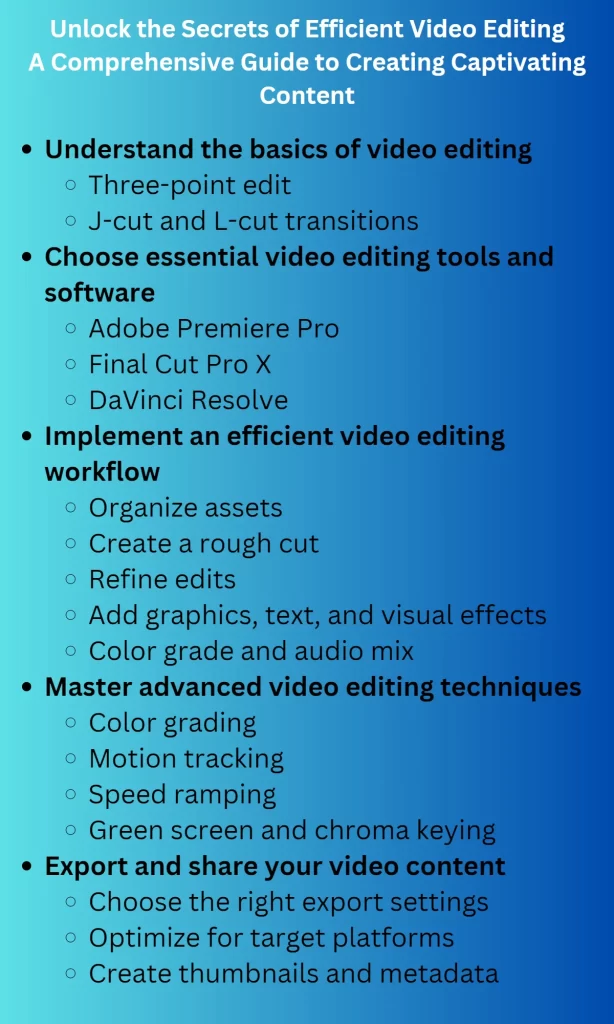Video editing has become a crucial skill in the digital age, transforming raw footage into polished content that can engage and captivate audiences. This comprehensive guide will give you the keys to video editing in minutes, with detailed instructions and insights to help you create stunning video content.
Understanding the Basics of Video Editing
Before diving into the intricacies of video editing, it is essential to grasp the fundamental concepts that underpin the process.
The Three-Point Edit
The three-point edit is a foundational technique that involves selecting an in-point, an out-point, and a destination point in your timeline. This enables you to control your video clips’ placement and duration precisely.
- In-Point: The beginning of the segment you want to include in your project.
- Out-Point: The end of the segment you want to have in your project.
- Destination Point: You want to insert the selected part in your project timeline.
J-Cut and L-Cut Transitions
J-cuts and L-cuts are essential techniques for smooth transitions between video clips.
- J-Cut: The audio from the following clip begins before the video transitions.
- L-Cut: The audio from the current clip continues after the video transition occurs.
These transitions can make your video edits feel more natural and seamless, enhancing your content’s overall flow and pacing.

Essential Video Editing Tools and Software
Choosing the right video editing software ensures a smooth and efficient editing process. Some popular options include:
- Adobe Premiere Pro: An influential, industry-standard software professionals and hobbyists use.
- Final Cut Pro X: Apple’s professional-grade video editing software with a sleek, user-friendly interface.
- DaVinci Resolve: A robust software offering advanced color grading, audio editing features, and video editing capabilities.
Efficient Video Editing Workflow
Implementing an efficient workflow is key to mastering video editing in minutes. The following steps can help streamline your editing process:
- Organize Your Assets: Create a well-structured folder system to store your raw footage, audio files, graphics, and other assets.
- Create a Rough Cut: Assemble your clips in the desired sequence, trimming excess footage and ensuring the overall flow of your project.
- Refine Your Edits: Adjust the pacing and transitions, and fine-tune your cuts to create a polished and cohesive final product.
- Add Graphics, Text, and Visual Effects: Enhance your video with titles, lower thirds, and other visual elements to add context and depth to your content.
- Color Grade and Audio Mix: Adjust the color balance and audio levels to create a consistent, professional look and sound for your video.
Advanced Video Editing Techniques
Mastering advanced video editing techniques can help elevate your content to new heights:
Color Grading
Adjusting your footage’s color balance and tones can dramatically impact your video’s overall mood and aesthetic. Utilize color grading tools like Lumetri Color in Adobe Premiere Pro or the Color page in DaVinci Resolve to achieve a unique and professional look.
Motion Tracking
Motion tracking allows you to follow the movement of objects or people within your video and attach graphics, text, or visual effects to them. This technique can enhance your storytelling and create dynamic, engaging visuals.
Speed Ramping
Speed ramping involves changing the speed of a video clip to create smooth slow-motion or fast-motion effects. This technique can dramatically impact your footage and help emphasize specific moments or actions.
Green Screen and Chroma Keying
Green screen technology and chroma keying enable you to replace the background of your footage with another image or video. This technique is widely used in film and television production to create realistic, immersive environments or special effects.
Exporting and Sharing Your Video Content
Once you have completed the editing process, it’s essential to export and share your video content in the appropriate format for your desired platform:
- Choose the Right Export Settings: Select your target platform’s appropriate file format, resolution, and bitrate. Standard video formats include H.264 for web-based platforms and ProRes or DNxHD for high-quality archival purposes.
- Optimize for Your Target Platform: Each platform may have specific requirements or recommendations for video content. Consult YouTube, Vimeo, Facebook, or other media guidelines to ensure optimal playback and quality.
- Create Thumbnails and Metadata: Design an eye-catching thumbnail and add metadata, such as titles, descriptions, and tags, to improve discoverability and engagement with your video content.
By following this comprehensive guide and mastering the art of video editing in minutes, you’ll be well-equipped to create stunning, professional-quality video content that can engage and captivate your target audience.
FAQ
What are the basic concepts of video editing?are the basic concepts of video editing?
The basic video editing concepts include the three-point edit (in-point, out-point, and destination point) and smooth transitions such as J-cuts and L-cuts.
What are some popular video editing software options?
Popular video editing software options include Adobe Premiere Pro, Final Cut Pro X, and DaVinci Resolve.
How can I establish an efficient video editing workflow?
Organize your assets, create a rough cut, refine your edits, add graphics and visual effects, and perform color grading and audio mixing to establish an efficient video editing workflow.
What advanced video editing techniques should I learn?
Master advanced techniques such as color grading, motion tracking, speed ramping, and green screen and chroma keying to elevate your video editing skills.
How can I export my video content for optimal quality on different platforms?
Choose the correct export settings, optimize your video for the target platform, and create thumbnails and metadata to ensure optimal quality and discoverability.
What are J-cut and L-cut transitions?
J-cuts and L-cuts are transitions where audio from the following clip starts before the video transition (J-cut) or audio from the current clip continues after the video transition (L-cut).
How can I improve the pacing of my video edits?
Refine your edits by trimming excess footage, adjusting transitions, and fine-tuning cuts to create a polished and cohesive final product with smooth pacing.



